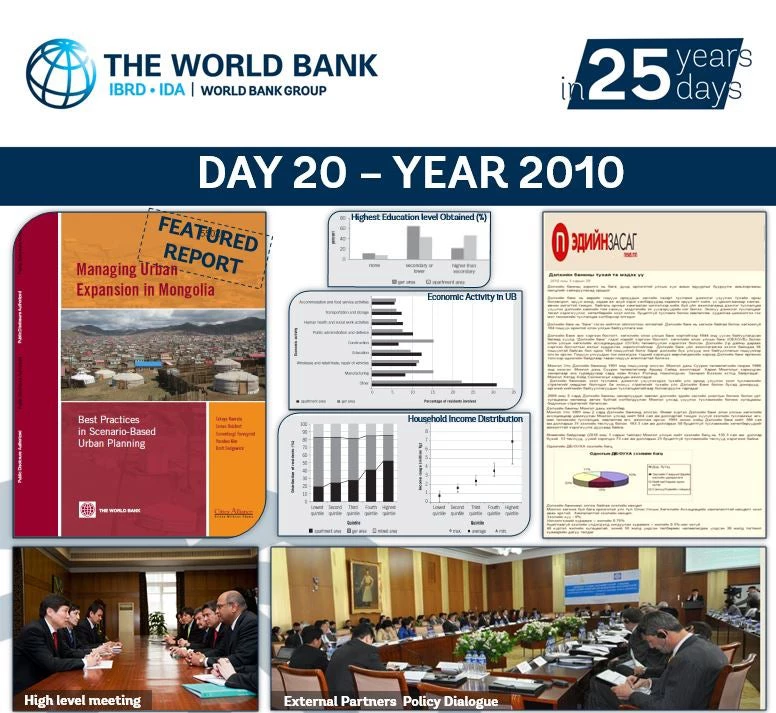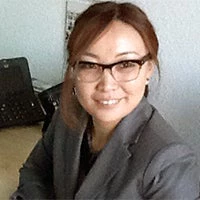
Given the rapid expansion of the UB city and the population growth reaching 40 percent of the country’s population, many other challenges had been facing the UB city authorities and its residents besides the smoke and the air quality. More than 60 percent of the city’s population lived—and they still do—in the so-called ger areas and these people lack basic services such as piped-in water, sanitation, paved roads, public transportation, etc. Managing the continuous expansion of the ger areas attained significant attention in the Government’s national and local development strategies and action plans, but implementation of measures proved to be challenging in practice. In order to help the Government better assess the various scenarios of the city’s development, the World Bank carried out extensive analytical work and published a report in 2010 titled Managing Urban Expansion in Mongolia: Best Practices in Scenario-Based Urban Planning. Compared to the previous studies undertaken by the Bank that focused on one or a few specific areas of UB city development, this report covered a issues ranging from land and housing to water supply, from roads and public transportation to solid waste management, heating and electricity, as well as education and health. The UB city Mayor at the time, Mr. Bat, endorsed the report, noting that this piece of analytical work had set the guiding principles for ger area development in UB city and would serve as the basis of dialogue between the UB city authorities, ger area residents, local communities, external partners and donors.
Speaking of external development partners, the Government of Mongolia and the World Bank Mongolia office jointly organized, on June 8, 2010, the “Government of Mongolia- External Partners Policy Dialogue”, which was attended by the Ministers and heads of relevant institutions, Members of the Parliament, and representatives from development partners and the private sector. The Policy Dialogue aimed to listen to the Government’s achievements and challenges as it implements its policy reforms, focusing explicitly on matters of ensuring fiscal sustainability, improving the social welfare system, promoting a healthier banking sector, and continuing real sector growth after the crisis of the previous two years.
Following the Development Policy Credit approved the previous year amidst economic and fiscal difficulties, in 2010 the Bank continued to extend its support to the Government of Mongolia with additional budget support of USD 29 million and a technical assistance project of USD 12 million to further assist the country overcome the recent economic downturn. On the economic analysis side, the Bank colleagues continued issuing the timely Economic Updates on a monthly basis, published the Economic Retrospective: 2008-2010 and also delivered just-in-time policy notes addressing impacts of the recent economic crisis including Tertiary Education in Mongolia: Meeting the Challenges of the Global Economy, and Rapid Assessment of the Effect of the Economic Crisis on Health Spending.
During 2010 the Bank also approved additional financing for three of its ongoing operations that had proven their worth and were still in demand. Those included additional financing of the Energy Sector Project, Index-Based Livestock Insurance Project, and the Rural Education and Development (READ) Project for USD 12 million, USD 10.7 million and USD 1 million respectively.
All in all, the year of 2010 proved to be a challenging one for the country on various fronts given the continued economic difficulties which called for better policies, and the harsh winter which brought the terrible dzud disaster in rural areas and worsening air pollution in the city. The country and its policy makers strived to meet these challenges and the World Bank continued to provide its support where needed, honoring its ongoing commitment to the country’s development and its reputation for delivering on those commitments.
Next we take another day to look closely into 2011, a year of spectacular growth. Please stay tuned and continue our journey with us.
Prepared in collaboration with Gerelgua Tserendagva and Dulguun Byambatsoo.
(Please follow our 25 years in 25 days journey here and on twitter with the hashtag #WBG_Mongolia25th)


Join the Conversation